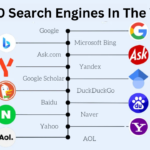
What Is The Complete Process of SEO To Rank In The Top Of The Websites?
Search Engine Optimization (SEO) is a dynamic and multifaceted process aimed at improving a website’s visibility in search engine results pages (SERPs). Achieving top rankings requires a strategic and systematic approach. In this guide, we will outline the key processes involved in SEO to help your website climb to the top.
1. Conduct Keyword Research
Why It Matters
Keywords are the foundation of SEO. Identifying the right keywords ensures your website aligns with user search intent.
How to Do It
- Use Keyword Tools: Leverage tools like Google Keyword Planner, SEMrush, or Ahrefs to find high-volume, low-competition keywords.
- Analyze Competitors: Identify which keywords your competitors are ranking for.
- Focus on Long-Tail Keywords: These are more specific and often less competitive, making it easier to rank.
- Understand Search Intent: Ensure the keywords align with what users are searching for, whether it’s informational, navigational, or transactional intent.
2. Perform On-Page Optimization
Why It Matters
On-page optimization involves tweaking elements of your website to make it more search-engine-friendly and user-friendly.
Key Steps
- Optimize Titles and Meta Descriptions: Write compelling, keyword-rich titles and descriptions for every page.
- Use Header Tags: Structure your content using H1, H2, and H3 tags to improve readability and SEO.
- Incorporate Keywords Naturally: Place primary and secondary keywords strategically in your content.
- Improve URL Structure: Use short, descriptive URLs that include target keywords.
- Optimize Images: Use descriptive alt tags and compress images for faster loading.
- Internal Linking: Link to other relevant pages on your site to improve navigation and reduce bounce rates.
3. Create High-Quality Content
Why It Matters
Content is king in SEO. High-quality, engaging, and informative content attracts users and encourages them to stay on your site longer.
How to Do It
- Publish Regularly: Consistently produce fresh and relevant content.
- Focus on E-A-T: Ensure your content demonstrates Expertise, Authoritativeness, and Trustworthiness.
- Use Visuals: Incorporate images, videos, and infographics to make your content more engaging.
- Address User Questions: Create content that answers frequently asked questions in your niche.
- Update Old Content: Regularly refresh outdated content to maintain its relevance.
4. Optimize for Technical SEO
Why It Matters
Technical SEO ensures that search engines can crawl and index your website effectively.
Key Steps
- Improve Website Speed: Use tools like Google PageSpeed Insights to identify and fix performance issues.
- Ensure Mobile-Friendliness: Use responsive design to make your site accessible on all devices.
- Fix Broken Links: Regularly check for and resolve broken links.
- Submit XML Sitemap: Help search engines crawl your site more efficiently by submitting a sitemap.
- Implement HTTPS: Secure your site with an SSL certificate.
- Use Structured Data: Add schema markup to enhance search result appearances with rich snippets.

5. Build High-Quality Backlinks
Why It Matters
Backlinks from reputable websites signal to search engines that your site is trustworthy and authoritative.
How to Do It
- Guest Blogging: Write articles for reputable sites in your niche.
- Outreach Campaigns: Reach out to influencers, bloggers, and website owners for backlink opportunities.
- Create Link-Worthy Content: Publish valuable content, like guides, infographics, or research reports, that others will want to link to.
- Monitor Backlinks: Use tools like Ahrefs or Moz to track and analyze your backlink profile.
6. Enhance User Experience (UX)
Why It Matters
Search engines prioritize websites that offer a seamless user experience.
Key Steps
- Improve Site Navigation: Make it easy for users to find information on your site.
- Reduce Bounce Rates: Create engaging content and a visually appealing design to keep users on your site.
- Use Clear CTAs: Encourage users to take action with compelling call-to-action buttons.
- Optimize for Accessibility: Ensure your site is usable by individuals with disabilities.
7. Focus on Local SEO (If Applicable)
Why It Matters
Local SEO helps businesses attract customers in specific geographic areas.
How to Do It
- Claim Your Google Business Profile: Optimize your profile with accurate information and relevant keywords.
- Use Location-Specific Keywords: Target keywords that include your city or region.
- Encourage Reviews: Positive reviews on platforms like Google and Yelp improve local rankings.
- Build Local Citations: Ensure your business information is consistent across directories.
8. Leverage Analytics and Tracking
Why It Matters
Analytics helps you measure the effectiveness of your SEO efforts and identify areas for improvement.
Key Tools
- Google Analytics: Track traffic, user behavior, and conversions.
- Google Search Console: Monitor your site’s performance in search results.
- Heatmaps: Use tools like Hotjar to understand how users interact with your site.
9. Stay Updated with Algorithm Changes
Why It Matters
Search engine algorithms are constantly evolving. Staying informed ensures your strategies remain effective.
How to Do It
- Follow SEO Blogs: Regularly read industry-leading blogs like Moz, Search Engine Journal, and Neil Patel.
- Participate in Webinars: Join SEO webinars and conferences to learn about the latest trends.
- Experiment and Adapt: Continuously test and refine your strategies based on algorithm updates.
10. Be Patient and Persistent
Why It Matters
SEO is a long-term investment. Consistent effort and patience are required to achieve and maintain top rankings.
How to Do It
- Set Realistic Goals: Understand that results may take months to materialize.
- Monitor Progress: Regularly review your metrics to ensure you’re on track.
- Stay Committed: Continuously optimize and adapt your strategies for sustained success.

Conclusion
Ranking at the top of search engine results requires a comprehensive and ongoing SEO process. By focusing on keyword research, on-page optimization, high-quality content, technical SEO, backlinks, user experience, and analytics, you can steadily improve your website’s visibility. Stay informed about industry trends and remain persistent in your efforts to achieve long-term success.
Read More:
What is the basic process of SEO?
How To Rank Our Website On Google In First 10?










